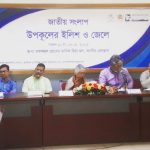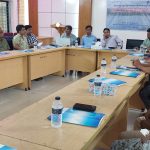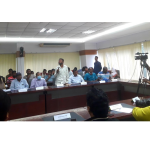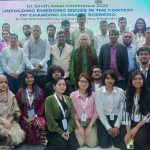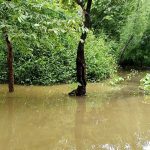A history of the problem in Chittagong, the second largest metropolitan commercial capital of the country, is the salimity in drinking water. Although the trend of salinity in the drinking water supplied by WASA was first observed in 1995, the problem of salinity in the water supplied by WASA at a specific time since 2007 has become quite serious. Whereas in 2007 excess salinity was detected in the water around March-April, in 2009 the problem appeared in the beginning of March and it gradually became severe in April-May. In a seminar organized by IED to celebrate Environment Day’07 at Lions Foundation Hall in 2007, I stated that this problem will continue to grow pgvi^q and once people of Chittagong city drink salt water throughout the year, it would be out of hand and there will be nothing to do or say. Now the signs are starting to become visible. Salinity levels and time spans have increased far in just a few years. The problem of fresh water has become severe in the areas of chittagong city where water is collected and supplied from the Halda river. It should be mentioned here that, WASA provides about 40% of the water supplied to the city from Halda river. This problem becomes evident when the salinity of Haldar water increases. Kaptai Lake is the main source of Halda river’s water. When the water in Kaptai Lake falls below the vivek limit, the dam authorities stop water supply to Halda river. As a result the Halda river got deprived of the fresh water. On the other hand, one of the fresh water sources of the river is percolation of underground water. It would not be an exaggeration to say that the percolation process is completely absent in the part of Halda that flows past Chittagong city. Because the percolation process requires sufficient ground water, about 60% of the water supplied to Chittagong city comes from ground water sources. On the other hand, as WASA can supply less water than the city needs, most house owners use underground water through tubewells for their own use and renters needs. Although the exact number of such tubewells is not known by WASA authorities. Or even if known, with the connivance of some dishonest and corrupt WASA officials, the house owners are easily carrying out this illegal activity. A study conducted by the author in 2008 entitled “Drinking water supply system in Chittagong metropolis” shows that out of 687 houses in Chawkbazar, Badurtala and Shulakbahar areas, 147 houses have tube wells through which ground water is extracted. And thus, due to the extraction of ground water, the pressure on the ground water reservoir is increasing and the percolation of water is decreasing. On the other hand, the infiltration process of water is hindered due to lack of rainfall and not raining at the right time and there is no open and raw space in the city, ground water recharge is decreasing cannot be stored. At one hand, unplanned extraction of ground water and on the other, due to obstruction of water infiltration process, along with other problems, water percolation process stopped. As a result, Halda river is deprived of clean water. Also, since the part of Halda flows through the rural areas, clean water cannot be connected to Halda due to unplanned, unscientific and environmentally destructive construction of sluice gates in the canals connected to Halda river. All these sluices are destroying Halda river’s fish fries and disrupting Halda river’s water flow and fresh water source. Prolonged inundation during the rainy season at some places causing massive crop losses, destruction of natural fish stocks. All the above factors have combined to completely destruction of Halda rivers’s fresh water source. Earlier Halda got 29% of its water from Karnaphuli, the rest received from hills, canals, bevels and underground sources, now due to the fact that all these sources have become extinct, Karnaphuli supplies 47% of Halda’s water. I cannot but have to mention, the sea level is increasing due to climate change. In this way, the salty water of the Bay of Bengal is easily entering Halda and the WASA authority is supplying this salty water to the city dwellers. In addition to drinking water supplied by WASA in 2009, salinity has also been observed in underground water drawn by tube wells and this is avivwek due to reduced groundwater flow due to increase in backwater pressure due to capillary properties of water from Halda during high tide. Saline water is stored underground in the process of percolation and comes up when extracted through tube wells. As the groundwater storage rate is decreasing, this problem became more pronounced in the city during the summer season. In a country like Bangladesh, the cost of purifying and supplying water is very high, so the WASA authorities have been forced to carry out this work for three years and the problem will continue to increase over the days, the solution of which is not in the hands of the WASA authorities at all. Instead, WASA authorities will play a stronger role to increase it. Because they will supply underground water under the pressure of the city dwellers which will reduce the water seepage more and eventually it will stop completely. According to WASA authorities, currently the daily water demand in Chittagong city is 50 million cubic liters but WASA can supply only 18 million cubic meters. In the next financial year Chittagong City Corporation and Chittagong WASA are jointly going to implement a project of Tk 1200 crore financed by the World Bank. Under this project WASA will ensure supply of drinking water in Chittagong metropolis. If WASA takes the initiative to solve the water demand of the city dwellers by extracting underground water through this project, then it will be suicidal for Chittagong city. As so this will result in the desertification of the Chitttagong city as well as salinity will spread thoughout this city. Besides, the possibility of disasters
Fresh Water Crisis: Families Embrace Local Tank Idea To Save Water
“This locally-led adaptation could be a solution for more communities but lacks support from governments.” “When it rains, it’s thrilling to us like a festival,” Adori Rani Das, a widow with three children, said as she described the lack of fresh water in her community on the coast of Bangladesh. “The freshwater crisis makes our life horrible. Sometimes I drink less to save (water) for the coming days,” Rani said as she sliced vegetables for lunch in her same-pucca house in Jelepara, a fishing community in the northern Katghar area of Chittagong District. “We have to buy water for cooking and drinking,” she said, adding that a gallon of drinkable water costs 60 BDT (US0.60). “We wash the rice and vegetables primarily with saline water and then wash with fresh water before cooking,” Rani said, adding the process is common among most families in the area to save purchased water for cooking and drinking. Global warming and rising sea levels are having severe impacts on the coast of Bangladesh, leading to more intense storms during the monsoon season and increasing levels of water salinity which puts pressure on freshwater resources in coastal communities like Jelepara. Better watershed management is needed to protect and improve the quality and storage of water and strengthen the resilience of communities. However, the lack of action by national authorities has prompted local communities to come up with their adaptation to the impacts of climate change. The rising salinity of Bangladesh’s freshwater supply poses a major water security threat for millions of people living along the coast, experts say. What has long been a problem in the southwest districts of Bangladesh is now gradually impacting the northern parts of the country. A 2017 study by the Soil Resources Development Institute found that salinity levels in rivers near the Bay of Bengal have increased significantly, and linger for longer. Soil salinity increased over 10 years (2005-2015) from 7.6 to 15.9 parts per thousand (ppt), compared to an acceptable level of 0.4 to 1.8 ppt, according to the study by the SRDI, which is part of the Ministry of Agriculture. Another study by the Centre for Environmental and Geographical Information Service (CEGIS), a subsidiary of Bangladesh’s water resources ministry, measured the average extent of seawater intrusion in coastal areas and classified it into three sections. The Assessment of Sea Level Rise and Vulnerability in the Coastal Zone of Bangladesh through Trend Analysis — is based on 30 years of data. It found that, on average, seawater intrusion in the Ganges tidal floodplain is 7-8mm per year; in the Meghna estuarine floodplain 6-9mm per year; and along the Chittagong coastal plan 11-20mm per year. Experts say saltwater intrusion can be linked to a combination of the impacts of climate change and a lowering of the groundwater table. “Both phenomena work synergistically,” Dr. Reaz Akter Mullick, a professor in the Department of Civil Engineering at Chittagong University of Engineering and Technology (CUET). PUBLIC HEALTH AT RISK The salinity of groundwater in most coastal districts is several levels above the acceptable level for safe drinkable water recommended by the World Health Organization (WHO), according to a study by Bangladesh’s Department of Public Health and Engineering (DPHE). The study found that in most coastal areas, the level of salinity (chloride count) in the main or secondary aquifer ranged from 103 to 12,433 milligrams/liter during the dry months and 34 to 11,366 milligrams/liter in the rainy season. In both cases, the extremes are far above the prescribed 300 milligrams/liter for freshwater and the drinkable range of 300-600 milligrams/liter. The most serious health impacts in coastal areas affected by high salinity are felt by teenage girls and women. For example, the lack of fresh water can lead to menstrual hygiene problems. Rani had experienced infections and itching during her monthly period and her physician prescribed the use of fresh water. But Rani said that was difficult to secure. “I have to suffer from pain every month,” Rani said, adding that her gynecologist prescribed a medicine to help relieve her pain that cost about 100 BDT a month. Rani’s experience is shared by many women and men living in coastal areas with high salinity levels who suffer from skin diseases, high blood pressure, and insomnia. Hygiene is a key factor in women’s health, particularly for those from poor families who rely on reusing old rags during menstruation, said Shahana Akther, Head of the Gynecologist Department at Chattogram Medical College Hospital (CMCH). Akther blamed the lack of fresh water on women failing to maintain their menstrual hygiene. “The women have to bear the pain in the long run,” she said. �

